Vessel Types of Colonial Massachusetts
Introduction
ABIGAIL, Arbella, and Mayflower are important names in the maritime history of Massachusetts, for they were the three ships that brought the early settlers to Salem, Boston, and Plymouth respectively. To these names we might add those of the vessels involved in unsuccessful efforts to establish earlier colonies. There was Concord with which Bartholomew Gosnold attempted a settlement on one of the Elizabeth Islands in 1602 and Gift of God and Mary & John that carried men and supplies for the Popham colony at the mouth of the Kennebec River in 1607. We must remember here that what is now the State of Maine was part of Massachusetts until 1820.
People growing up in Massachusetts hear and read so much about the first three ships that they are likely to assume that everything is known about them. Unfortunately the reverse is true. Of the hundreds of vessels that brought thousands of settlers to the English North American colonies during the seventeenth century the names of some are not known, the tonnages or dimensions of others are missing, and there are only two contemporary representations. These are plaster ceiling decorations in Hook House located near Tisbury, Wiltshire, England, depicting the 300-ton ship Ark and the fifty-ton pinnace Dove that landed the first settlers in Maryland in 1634.
Concerning one important American vessel a researcher noted that there was some confusion about her, not for lack of information but because of a superabundance of misinformation. We face a somewhat similar situation when investigating the vessels and small craft employed in colonial Massachusetts. There is no lack of information about what they were. Acts of governing bodies, court records, letters, diaries, and the like are full of references to ships, barks, snows, brigantines, ketches, pinnaces, sloops, and shallops, and these are not all. Little is known, however, of their forms, construction, and rigs, although a few shipbuilders’ notebooks and printed works help to fill the gaps.
To my way of thinking some of the available material has been interpreted wrongly, more often in light of twentieth-century experience than in the context of the period. Some readers of this paper who have questioned me about some types of vessels are aware of my somewhat rude reply, the double-barreled question “When and where?” “When” is particularly important in this study, for the colonial period of Massachusetts lasted close to 175 years.
One reason for the paucity of material about the vessels employed in colonial Massachusetts is that the mariners of the period knew what they were sailing and the merchants knew what vessels they owned. Neither mariners nor owners had any reason to set down details that were common knowledge. In the absence of written descriptions, the obvious next source to the unknowing is plans—if a vessel was built there must have been plans. Ship plans as known today, however, did not exist in the seventeenth century or indeed for the whole American colonial period, but I believe that simplified draughts, perhaps even done on a smooth board or two, were commonly drawn by the better shipwrights.1 The less skilled never progressed beyond a few basic rules learned during their apprenticeships. Draughts on paper or vellum were usually preserved only by an organization such as the British Admiralty and its counterpart in other countries. No such organization existed in colonial Massachusetts.
To date the earliest-known draught of a North American-built vessel, that for the sloop Mediator built in the Chesapeake region in 1741–1742, was drawn from measurements taken off her after she had been purchased by the Royal Navy. The earliest draught for an assumed North American-built vessel, also drawn from measurements, was made in 1736. We know, however, that a draught was sent out from England in 1638 to Arthur Gill for the building of a vessel on Richmond Island near Cape Elizabeth; later in the century there are references to other draughts, but apparently none of these have been preserved.
With useful photography still more than three-quarters of a century in the future when Massachusetts ended its colonial status, we are dependent on the work of artists for portraits of vessels and shore and harbor scenes. But the first-known portrait of a named Massachusetts vessel, the letter-of-marque ship Bethel, was not painted until about 1748. There are, however, a number of sketches and port views which if not always of Massachusetts are at least colonial. One point might be clarified here—in general, a boat can be carried on a vessel but not the reverse. The term “boat,” however, in combination with another word—Bermuda, Chebacco, pilot, etc.—often designated a sizable craft. While the plural “ships” was often used when referring to all the vessels in a fleet, “ship” usually meant a vessel of a definite type.
If an early seventeenth-century seaman could walk into this symposium he would likely be highly amused and greatly mystified by our attempts—my attempts—to describe the sailing vessels of his day. We, in turn, would be equally amused by his names for the sailing vessels of the late nineteenth and early twentieth centuries. Our present system of classifying vessels by rig alone is relatively modern, dating only from the 1850s. The northern European and Scandinavian seamen retained, much later than those of the New World, definitions of vessels that depended to a certain extent on hull characteristics. Thus we can find such seemingly contradictory classifications as a snow-rigged frigate, a brigantine-rigged cat, or a ship-rigged bark.
Early Seventeenth-Century Ships
At any period in history there was a particular type of vessel that was the favored “ship” of its day, the highest development at that time. Some specific names have been cog, hulk, carrack, and galleon, which came into being when trade conditions and fashion changed enough to warrant the development of a vessel different from the current “ship.” As new types developed, the older ones continued in service for a considerable period, hence at any given time there might have been several types of large vessels that a sailor would have called “ships.”
During our country’s annual Thanksgiving celebration near the end of November, we are beset by innumerable paintings, drawings, sketches, cutouts, models, and what have you, of varying quality, all purporting to represent the Pilgrims’ ship Mayflower. These usually exaggerate the obvious hull features of seventeenth-century ships: the beakhead and prominent forecastle forward, the low waist amidships, and a high poop aft. I hope I will be forgiven for including yet another version as Figure 1, a photograph of Mayflower II after her Atlantic crossing in 1957.
The rig of these assorted versions of Mayflower is usually three-masted with two square sails on both the fore- and mainmasts, a lateen sail on the mizzenmast, and a small square sail—the sprit-sail—under the bowsprit. By our current rig classification system, a vessel so rigged is not a ship, for a ship must have at least three masts with square sails on all. The rig described, however, was standard for small and medium sized ships of the early seventeenth century; it could also be found on vessels classed as barks and pinnaces.
The first two decades of the seventeenth century saw a gradual change on large ships from two lateen rigged mizzenmasts—the main mizzen and the bonaventure mizzen—to a single mizzenmast with a lateen sail and a small square topsail. Some small naval vessels had the mizzen topsail by about 1630, but it was not common on small English merchant ships until about 1650.
Vessels of the early seventeenth century had some definite shape characteristics that often were masked by the decorative features so apparent in old paintings and prints. The topsides were most noticeable as they tumbled home to high, narrow decks; one reason for this was to keep superstructure weights to a minimum, consistent with space requirements. Below water the vessels had the traditional cod’s head and mackerel’s tail, but their underbodies were far from the crude, chunky shapes so often seen in models.
Of great importance in the design of any vessel was the shape of the largest section, the midship bend, and its fore-and-aft location on the keel. The outline of the bend was developed in accordance with long standing practice using a compass and a straight edge. Its usual position was a bit forward of the midlength of the vessel. The point of greatest breadth was just above the load waterline, and it was raised toward the ends to give fine sections below for easy passage through the water and extra buoyancy above to improve seaworthiness in heavy weather. From four basic curved lines running from bow to stern, the shape of any bend or frame could be drawn with a compass and straight edge. This mechanical system failed at the ends of a vessel, and there the art of the shipwright took over. Some of the shape characteristics mentioned above were the odd bumps that occurred where arcs of differing radii came tangent.
Having mentioned the major external features of early seventeenth-century ships, we can turn to their interiors. Shipbuilders’ notebooks and evidence from paintings and prints show that all but the largest ships had two decks in the main hull which usually did not run continuously from bow to stern. They were stepped up or down as necessary to suit space requirements within the hull and to avoid cutting gunports through the main wales, the heavy external fore-and-aft strength members. Occasionally the wales were also stepped but it was not until about 1650 that shipbuilders began cutting them.
Ballast, cables, barrels of water and beer, and cargo were carried in the hold below the lower deck while the ’tween deck space was cluttered up with armament, some cargo, stores, passengers, and crew. In ordinary merchant ships, the galley was often in the forecastle along with more stores. Perhaps a few of the crew slept there in hammocks, but the forecastle was not yet the traditional crew’s berthing space; most of the crew was expected to find soft sleeping spots among the spare sails and coils of rope on the lower deck.
The first level of superstructure aft extended from the mainmast to the stern, about half the length of the ship, hence the name “half deck.” Under it at the very stern was the great cabin, the quarters of the commander of the ship who was responsible for the trading or combatant activities. Forward of this cabin’s bulkhead was another compartment, the steerage, where the helmsman stood at the whip-staff, which passed through a roller set in the deck and was attached to the forward end of the tiller. Often there were cupboard berths along the sides of the steerage. The forward steerage bulkhead had doors giving access from the upper deck, and usually there was a small hatch in the half deck over the helmsman through which he could see some of the sails by day and receive orders at all times from the officer conning the ship. The latter-day unsavory reputations of the “steerage” and “half deck” all began here.
The second level of superstructure aft, the quarterdeck, again was so-named for its length. It covered a small cabin for the master who was responsible for the actual sailing of the ship. The rank of sailing master was retained in armed vessels to the end of the sailing era, but in the ordinary small merchant ships one man handled the duties of commander and master.
Barks
A seventeenth-century three-masted vessel having two masts square rigged and only a lateen sail on the mizzenmast is classed by many persons today as a bark as this rig meets our nineteenth-century definition. To confuse matters, as bark has often been used in a poetic sense to mean almost any type of watercraft, the English long ago chose to use barque when referring to rig. In the early seventeenth century, however, a bark was defined as a small ship or a large boat, which leads to different hulls and rigs.
The first type of bark, a small ship, was just that, a square- or round-sterned vessel with the standard small ship rig. Another definition distinguished barks from ships by the fact that barks had only simple crosstrees instead of large platforms [tops] at the heads of their lower fore- and mainmasts. Some small barks probably had no superstructures while on others they were lesser in extent than on ships, perhaps no forecastle and only one level aft.
The second type of bark, the large boat, often double-ended, had a two-masted square rig. Her large mainsail, carried on a mast stepped nearly at mid-length, was deep and narrow, and her similarly shaped foresail was quite small, having only about one-quarter the area of the main; the foresail became larger with the passing of time. Such a craft is shown in Figure 2.
From colonial records, it is difficult to determine to which type of bark the recorder was referring, but the smaller sizes had the simpler rig. Barks ranged in size from about twelve to one hundred tons, but the largest mentioned by John Winthrop measured about fifty tons. William Bradford and Winthrop, particularly the latter, sometimes added to the problem by using “bark” in a general sense to indicate a lesser vessel when they were not quite sure what to call her. The first named vessel built in the Massachusetts Bay colony was usually called a bark, Winthrop’s Blessing of the Bay launched at Medford on 4 July 1631. On the same date 145 years later our Ship of State was launched, and our colonial history ended. Blessing was preceded, however, by a vessel built in the colony more than two years earlier, which in May 1629 was also called a bark. It is possible that she may have been the vessel sent off trading in October 1630 by Governor Winthrop, Deputy Governor Dudley, and Samuel Maverick, at which time she was referred to as a pinnace.
Blessing of the Bay measured about thirty tons; hence it is possible that she carried the two-masted square rig although she may have been near the upper limit for it. There are a few examples, however, of what might be called a simplified ship rig created by adding a small lateen mizzen to this two-masted square rig. Vessels so rigged often carried a small main-topsail set flying from the deck and sometimes a fore-topsail as well; the seamen of the Low Countries called them “boat-ships.” In 1672 we can find a ten- to twelve-ton craft described as a bark or decked shallop, and, for reasons that will be apparent later, there is no question but that she carried the two-masted square rig.
John Winthrop made a specific reference to the bark carrying Lion Gardiner that arrived at Boston on 28 November 1635. He called her a twenty-five-ton “Norsey” [North Sea] bark, from which we may infer that she had some features that distinguished her from ordinary small barks. This vessel, named Bachelor, may have looked something like the “boat-ship” shown in Figure 3.
Bartholomew Gosnold’s Concord of 1602, mentioned earlier, was called a bark. Her size is not known but she carried a complement of thirty-two; based on this I have estimated that she measured about fifty-five tons. Plans for a modern reconstruction of her as a small ship without tops are available from the Old Dartmouth Historical Society in New Bedford, Massachusetts.
Pinnaces
By 1626 the Pilgrims at Plymouth had only open boats to use for fishing and their various trading enterprises along the coast of New England. “And finding they rane a great hazard to goe so long viages in a smale open boat, espetially ye winter season, they begane to think how they might get a small pinass,” wrote William Bradford, governor of the colony. The Pilgrims took one of their open boats, “sawed her in ye midle,” lengthened her five or six feet, built her up, laid a deck, and so converted her into a small vessel.
The pinnace category is probably the most confusing of all the early seventeenth-century vessel types. The term was applied at one time or another to practically everything from small open pulling boats to relatively large seagoing vessels that carried the standard ship rig. Some small pinnaces were transported on board larger vessels in a knocked-down form ready to be set up at the place of use.
The term “pinnace” came into the English language through the French pinasse from the Latin pinus meaning a pine tree or something constructed of pine. In this case, it meant a lightly built vessel in contrast to the usual heavy oak construction of large merchant and war vessels and in England and France it pointed further to a type derived from Scandinavia where pine trees were abundant. This would have been a vessel having lapped strakes of planking, a form of construction that today is usually called clinker-built. There is evidence that some late sixteenth- and early seventeenth-century pinnaces were so built, but it is unreasonable to conclude that all pinnaces had clinker planking.
There are but few definitions and descriptions of pinnaces. In 1634 Captain Nathaniel Boteler wrote that there was “no difference between a ship and a pinnace but in bulk and burthen”; in other words, a pinnace was just a small ship. Dutch draughts of the mid-seventeenth century show “pinnasschips” having only one deck but with the normal forecastle and after superstructure of the larger ships. In 1686 a pinnace was described as:
…a small vessel with a square stern which is propelled by sails and oars and which has three masts. It is suitable for exploring and for landing troops.
Although these and similar definitions are not particularly helpful, it is obvious that a vessel of light construction with oars as well as sails would be useful as a tender to a large ship in addition to the duties mentioned. Records of sixteenth- and seventeenth-century voyages contain many references to ships and their accompanying pinnaces; in some cases the pinnace was a sizable vessel. A small vessel intended to sail in company with a larger ship had to have a form and rig that would enable her, under normal circumstances, to keep up with the ship; in unfavorable circumstances pinnaces sometimes were towed. There is evidence that in relation to length, pinnaces were narrower than normal ships, but the shapes of the sections of both were about the same.
While “pinnace” derived initially from constructional features it came to indicate a use or service; almost any vessel could have been designated the “pinnace” to accompany a larger one. Vessels called pinnaces often voyaged alone, and in such cases the type name must be considered as applying to a lightly built square-sterned vessel suitable for the duties mentioned. Pinnaces ranged in size from about fifteen to 200 tons and in rig from a simple sprit mainsail with a staysail forward to the full ship rig.
The first vessel built in New England was called a pinnace, the thirty-ton Virginia. She was constructed during the winter of 1607–1608 under the direction of one Digby of London in the Popham colony at the mouth of the Kennebec. The plan of St. George’s Fort in the Spanish Archives has a sketch of a small vessel, Figure 4, that is thought to represent Virginia—a square-sterned, single-deck craft with one mast carrying a sprit mainsail and a staysail tacked to the stem head.
Because the pinnace Dove mentioned earlier came from Maryland to Boston late in August 1634 with corn to trade for fish and other commodities we can include her portrait as Figure 5A.2 This is rather confusing, but the artist was probably trying to show the rig depicted in Figure 5B, which was common in northern Europe. Although the fore staysail would have been hidden and blanketed by the deep, narrow mainsail the artist has shown it full of wind.
The smallest of the three vessels that carried the first settlers to Virginia in 1607 was the twenty-ton pinnace Discovery. In view of her size, it is likely that she had the two-masted square rig of our boat-type bark. In fact, considering that almost any vessel might have served as a pinnace, Discovery under other circumstances might have been called a bark.
A good example of a ship-rigged pinnace is shown in Figure 6, Black Pynnes, which carried the body of Sir Philip Sidney from Holland to England in 1586. Many of her features are hidden by the waist cloths and boarding nettings, but it is obvious that she has a short forecastle and a short poop. We do not know her dimensions, but her hull length may have been about seventy feet. For the next half century marine paintings, primarily of fleet actions, show many small vessels of this type, but they would have been rare in the Massachusetts Bay colony.
As the seventeenth century progressed we find in American colonial records an increasing use of other type names for small vessels employed for the same purposes as pinnaces were early in the century. Samuel Pepys probably was responsible for the elimination of the pinnace, for at the Restoration of Charles II in 1660 he listed all the vessels in the Royal Navy, and pinnaces were not set down as a separate type. The fighting ships were grouped into six “rates” depending on size and armament; buried in the list of “6th rates” was the old pinnace Henrietta of 1626, the only one labeled as a pinnace. Other small vessels occasionally called pinnaces may have been listed in some of the thirteen other categories that Pepys established.
Ketches
The ketch, in one of the many variants of the word, can be traced back to at least 1481. William Bradford mentioned ketches but once in his journal, and they do not appear in John Winthrop’s history until 1640. By the end of the seventeenth century, the ketch was New England’s primary offshore fishing vessel and was also employed for trading voyages that ranged from Newfoundland to the north, Barbados to the south, and overseas to Madeira, the Azores, and England.
Bradford’s reference to ketches concerned the ship carpenter who crossed the Atlantic to work at Plymouth. Before he died of the fever in the summer of 1624 he had, among other things, hewn the timbers for two ketches or “catches,” to use Bradford’s spelling. Why the decision was to build two ketches—instructions from Robert Cushman, the colony’s agent in England—instead of two barks or pinnaces is an intriguing problem.
As a type name, ketch applied to yachts, a special type of naval vessel, traders, and fishermen, but it has come down to us primarily as a rig usually described as a ship without a foremast. Evidence from a model, pictorial material, and a masting rule, however, show that ketches of the first half of the seventeenth century were quite unlike the “ship-without-a-foremast” concept. They were rigged, in fact, about the same as the vessel shown in Figure 5b; later versions carried a jib instead of the square sail under the bowsprit. For part of our definition, then, we must look to the hull.
From a mass of evidence we can draw some conclusions about the hulls of ketches. First, ketches were flush-decked vessels and very seaworthy. Second, ketches were relatively small, ranging in size from about ten to seventy tons with the smaller tonnages up to about thirty predominating. Third, ketches were relatively beamy, stoutly built, double-enders. Fourth, ketches were handy vessels. A modern reconstruction of a forty-ton trading ketch of about 1670 that has all of these qualities is shown in Figure 7.
Shallops
Shallops were ubiquitous in early Massachusetts maritime history. Before starting the construction of the pinnace Virginia, the Popham colonists built one shallop and later may have turned out two more. The shallop in which the Pilgrims explored the shores of Cape Cod Bay was carried in some sort of cut-down form in Mayflower; while at Provincetown the Pilgrims cut timber for another. The 1624 ship carpenter completed two shallops in the short time he worked at Plymouth. Six shipwrights came to Boston in Arbella and her consorts under orders to build at least three shallops that were to be sent out fishing as soon as completed. John Winthrop in Arbella noted on 11 June 1630 the presence of five or six shallops under sail off the Isles of Shoals, and his History of New England contains fifty-two other references to shallops.
Slup, schlup, sloep, chaloupe, and chalupa [Swedish, German, Dutch, French, and Spanish] indicate the widespread use of the type in Europe. The Basque shallop from the Bay of Biscay was particularly esteemed among seamen; it probably was the ancestor of the New Bedford whaleboat. Generally speaking, the shallop was an open, strongly built, double-ended work boat propelled by both oars and sails that was employed for inshore fishing and limited coastwise trading.
A modern reconstruction of the shallop carried on Mayflower is shown at anchor in the foreground of Figure 1; she is about thirty-three feet long with a beam of about nine feet. She is arranged for four oars on each side and her sailing rig consists of a staysail forward and a sprit main. Many shallops, however, had the two-masted square rig described earlier, for this was the basic rig of the Basque shallop.
There is not room in this paper to do more than mention a few of the minor types of watercraft employed in the early days of Massachusetts and some of the occasional visitors. “Canows,” adopted from the native Americans, were widely used along shore and even carried as tenders on small vessels. These were, of course, the heavy type carved from logs. “Boats” are impossible to define other than being undecked and propelled mainly by oars. Large naval vessels, and probably the large merchant ships as well, usually had three boats whose type name depended on size, shape, and construction—the long boat, usually towed astern; pinnace; and skiff. Occasionally there was a smaller fourth boat, the jolly-watt, about which we know nothing. Lighters were common and probably were what we would call scows, square-ended, shallow draft craft suitable for transporting heavy, bulky cargoes in protected waters and propelled by both oars and sails.
In 1643, John Winthrop mentioned a galliot which was primarily a two-masted Dutch type. To the English, a galliot was a ketch, but to the Dutch an English ketch was not a galliot. A Dutch hoy visited Boston in 1648; hoys were flat-bottomed vessels carrying single-masted, fore-and-aft rigs. Although the Dutch word “sloep” was one of the ancestors of “shallop” it defined for the Dutch an open boat, yet to Winthrop, who had shallops and open boats in his colony, a Dutch sloop was something different. As the ones mentioned came from New York they probably were decked, and they too very likely had a single-masted, fore-and-aft rig.
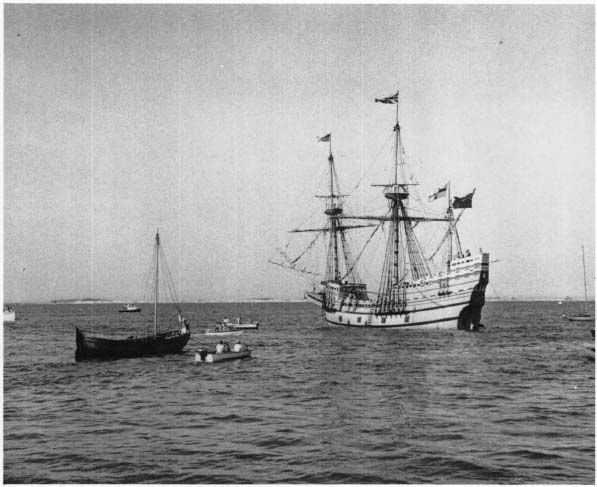
1. Mayflower II with her shallop after her Atlantic crossing in 1957. (Text p. 6)
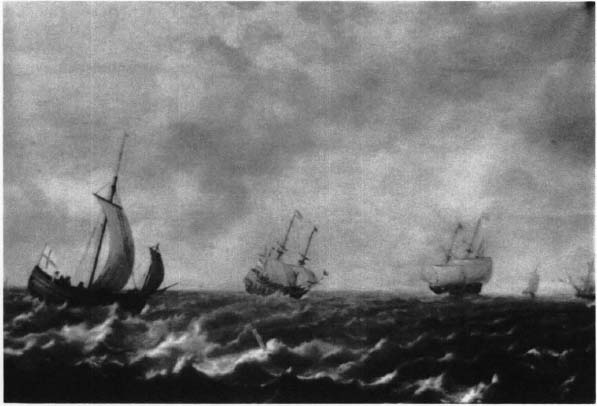
2. Two-masted bark (left) of the mid-seventeenth century. (Text p. 8)
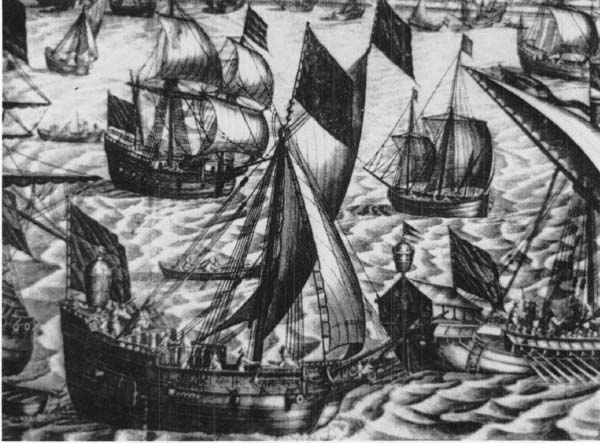
3. “Boat-ship” of the seventeenth century, from a view of Amsterdam. (Text p. 9)
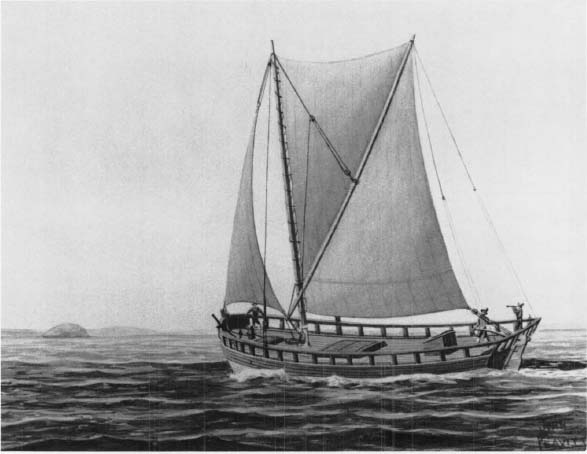
4. The 30-ton pinnace Virginia of Sagadahoc, built in 1607–1608. Watercolor by John F. Leavitt. (Text p. 11)
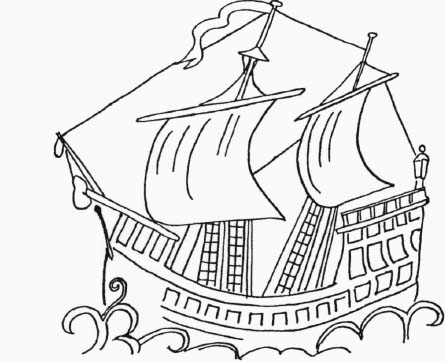
5A. Pinnace similar to Dove, 1633, which landed the first settlers in Maryland in 1634. After a plaster ceiling decoration in Hook House, Wiltshire, England. (Text p. 11)
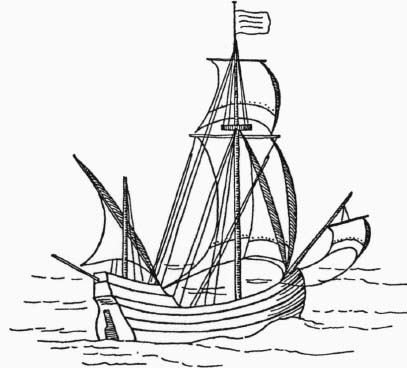
5B. Another pinnace similar to Dove. After Waghenaer. (Text p. 12)
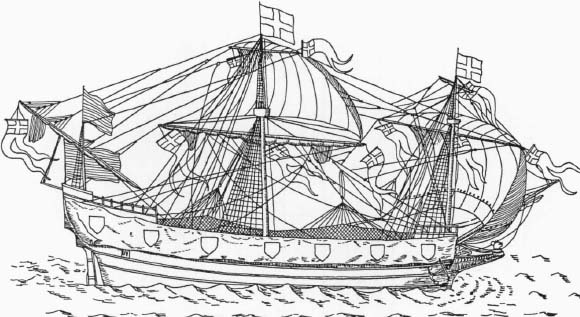
6. Ship-rigged pinnace Black Pynnes, circa 1586. After Lant. (Text p. 12)
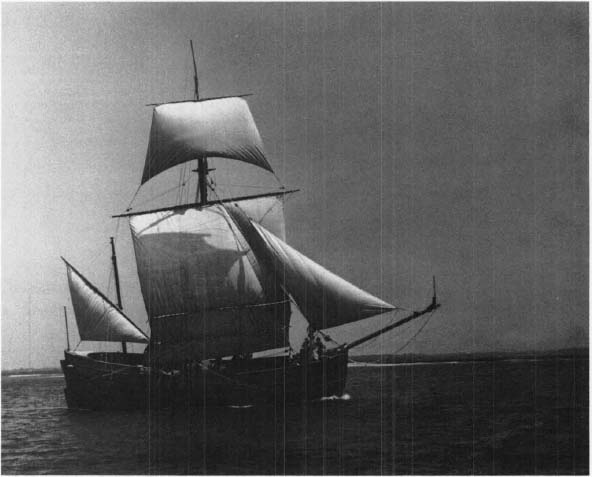
7. Modern reconstruction of the 40-ton trading ketch Adventure of about 1670. (Text p. 13)
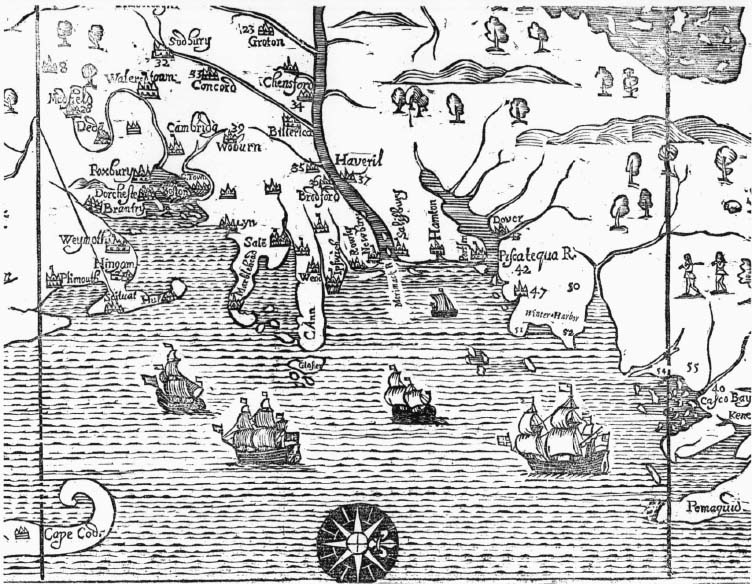
8. Section of the White Hills Map of New England, 1677, showing local craft of the period. (Text p. 15)
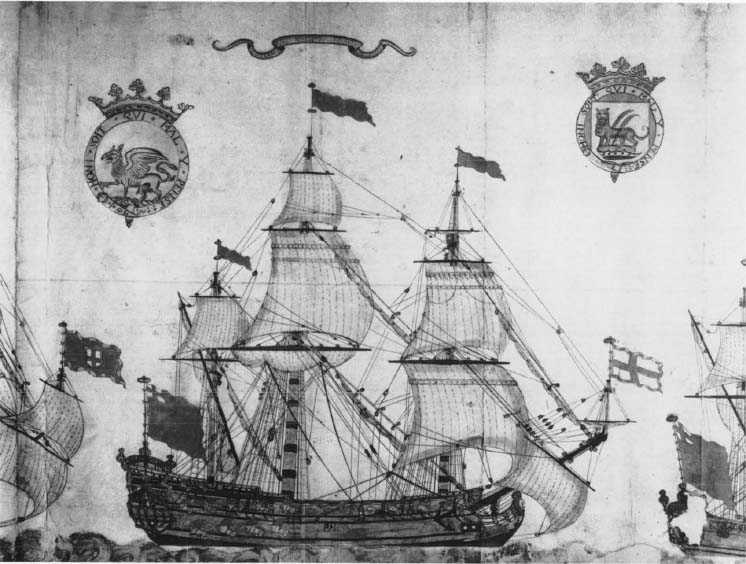
9. The ship William and John, circa 1670. (Text p. 15)
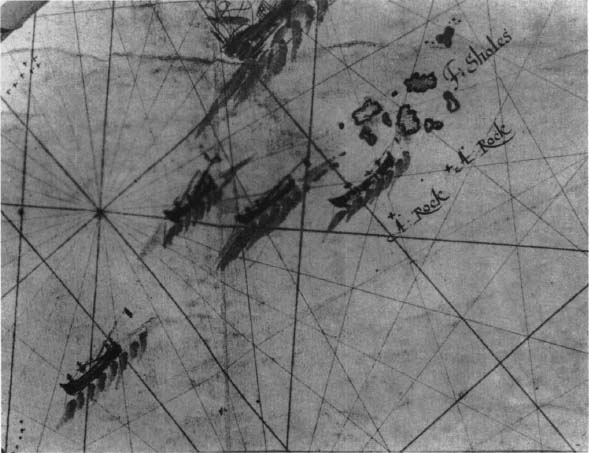
10. Detail of anchored shallops fishing off the Isles of Shoals, circa 1680. (Text p. 16)
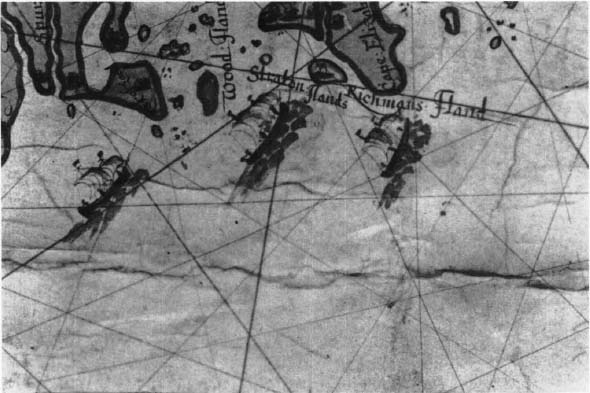
11. Detail of shallops under sail, circa 1680. (Text p. 16)
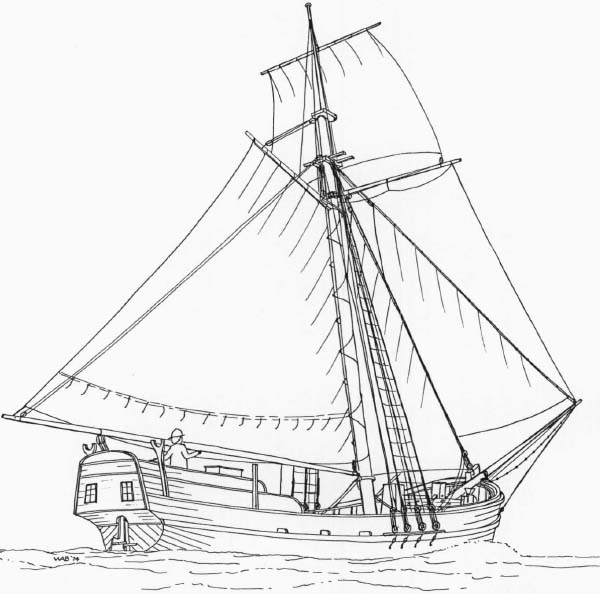
12. Modern reconstruction of a medium-sized sloop, circa 1680. (Text p. 18)
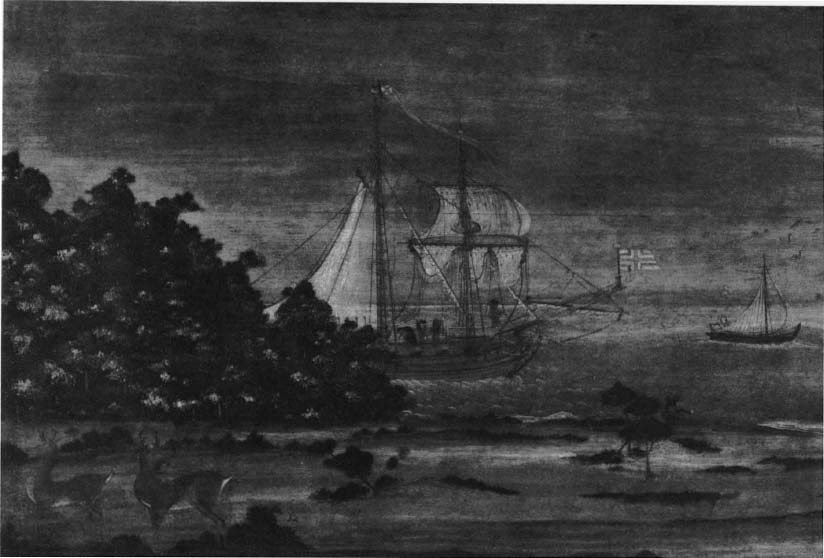
13. Detail of an oil overmantel painting, Richmond County, Virginia, circa 1715, showing a brigantine of the period. (Text p. 19)
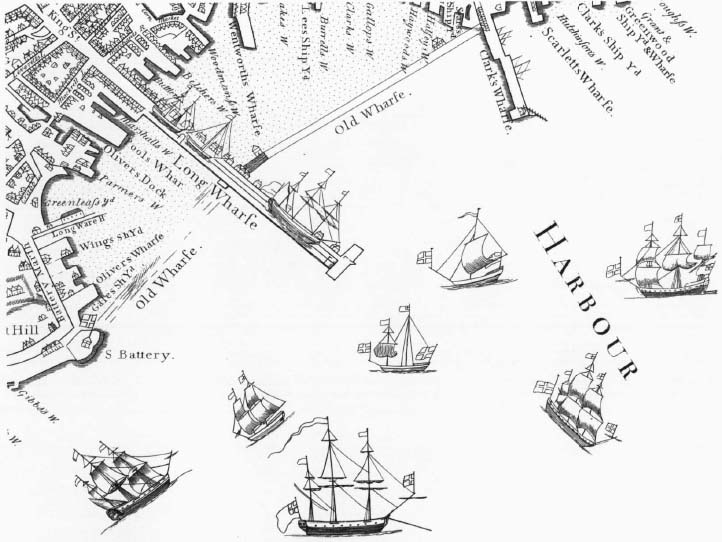
14. Detail of John Bonner’s Map of Boston, 1722, with local shipping. (Text p. 20)
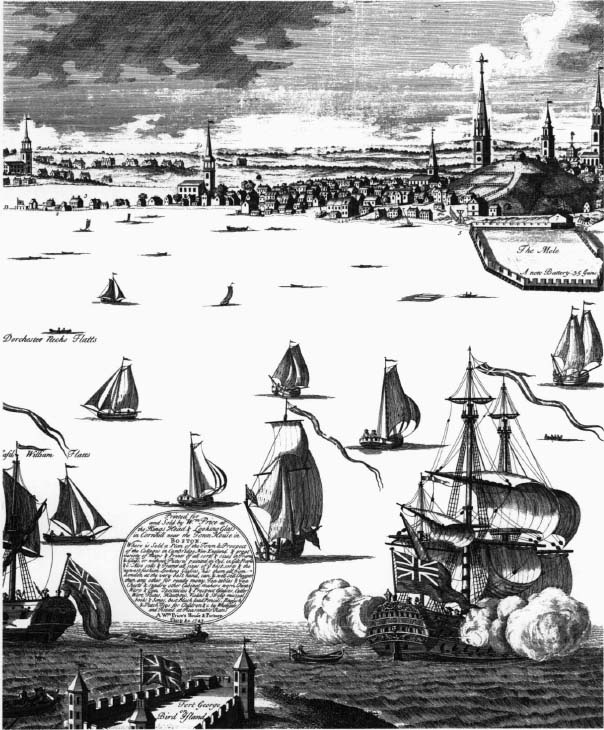
15. Left-hand section of “A South East View of ye Great Town of Boston in New England in America,” by William Burgis, 1743. (Text p. 20)
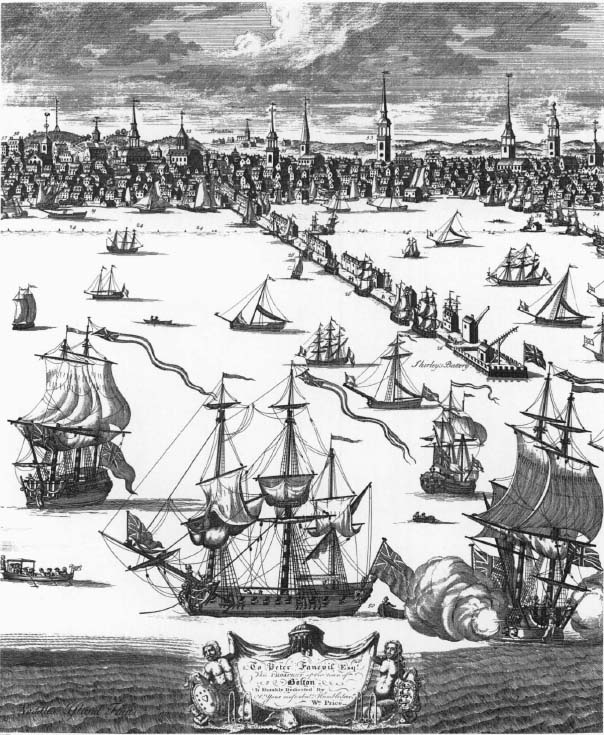
16. Middle section of “A South East View of ye Great Town of Boston in New England in America,” by William Burgis, 1743. (Text p. 20)
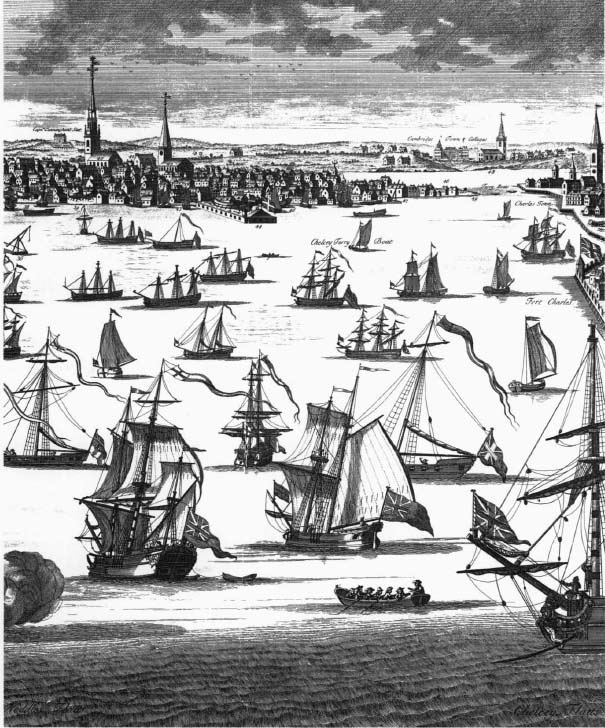
17. Right-hand section of “A South East View of ye Great Town of Boston in New England in America,” by William Burgis, 1743. (Text p. 20)
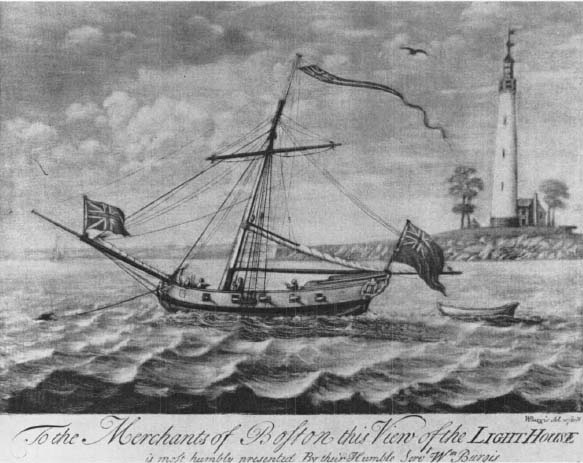
18. Sloop anchored off Boston Light, mezzotint by William Burgis, 1729. (Text p. 23)
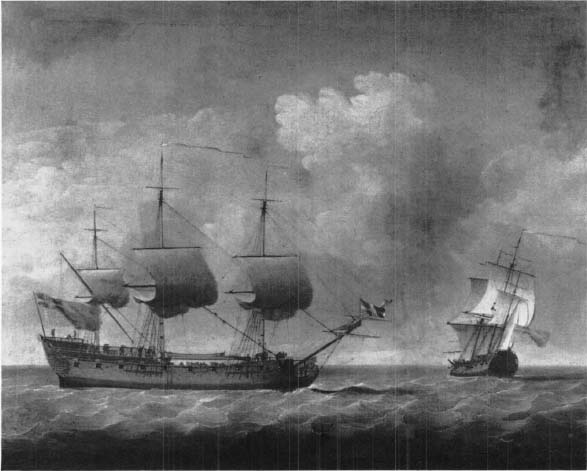
19. Letter of marque ship Bethel, 1748. (Text p. 24)
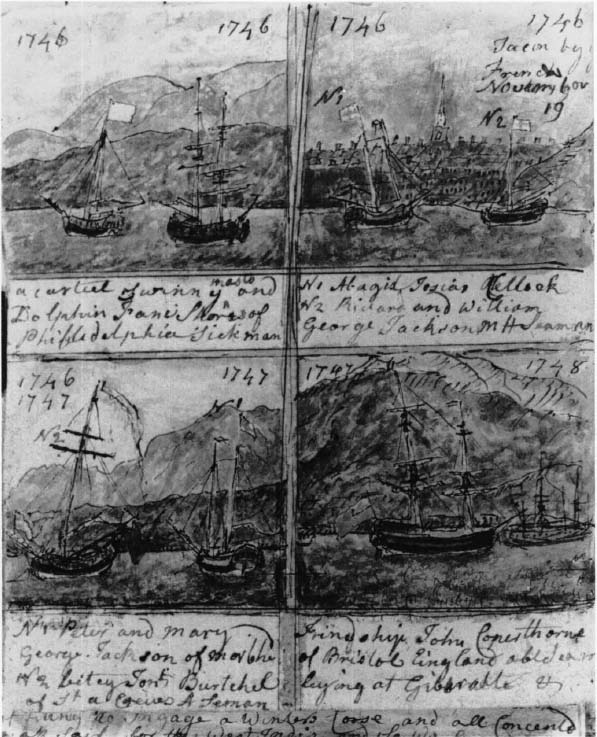
20. Shipping sketches by Ashley Bowen (1728–1813) of Marblehead. (Text p. 24)
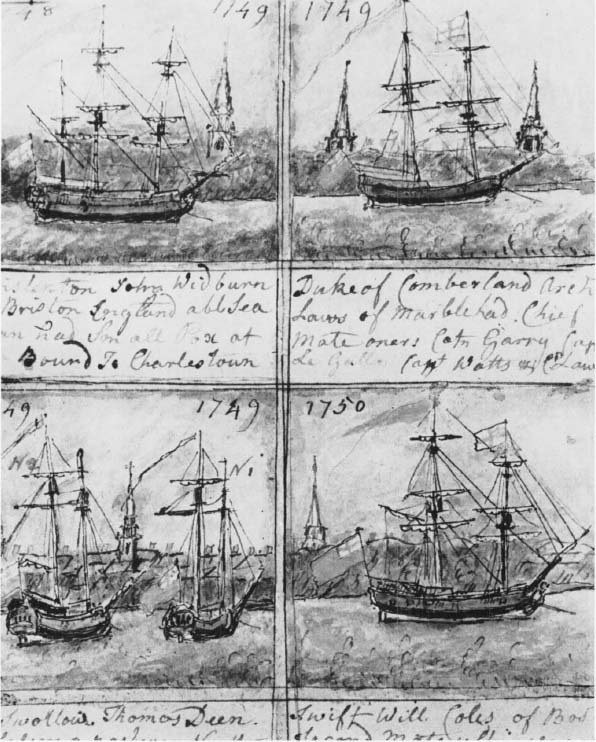
21. Shipping sketches by Ashley Bowen (1728–1813) of Marblehead. (Text p. 24)
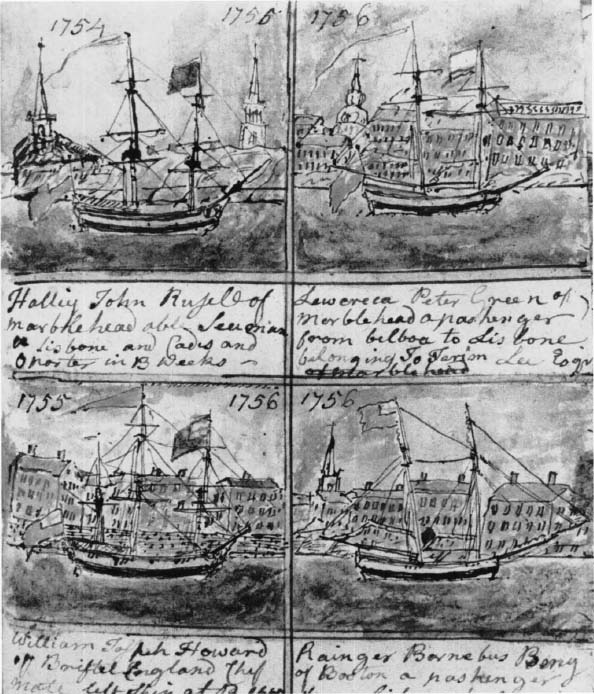
22. Shipping sketches by Ashley Bowen (1728–1813) of Marblehead. (Text p. 26)
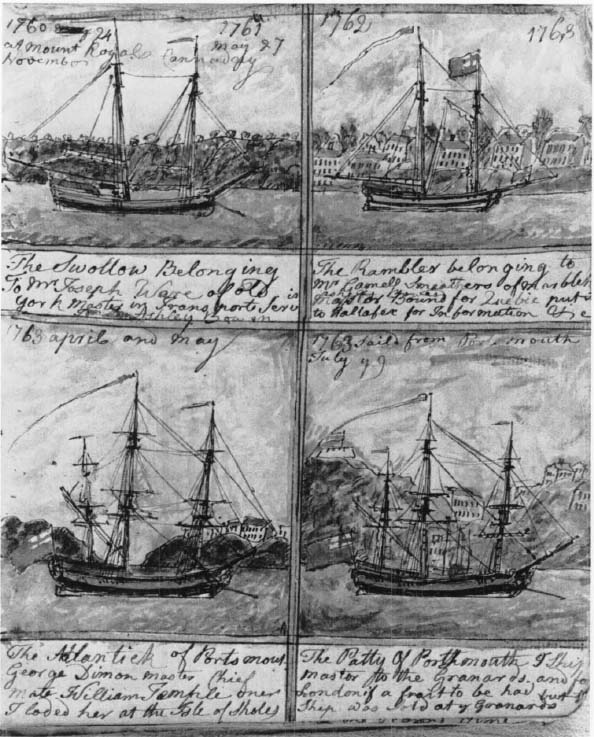
23. Shipping sketches by Ashley Bowen (1728–1813) of Marblehead. (Text p. 26)

24. Shipping sketches by Ashley Bowen (1728–1813) of Marblehead. (Text p. 26)
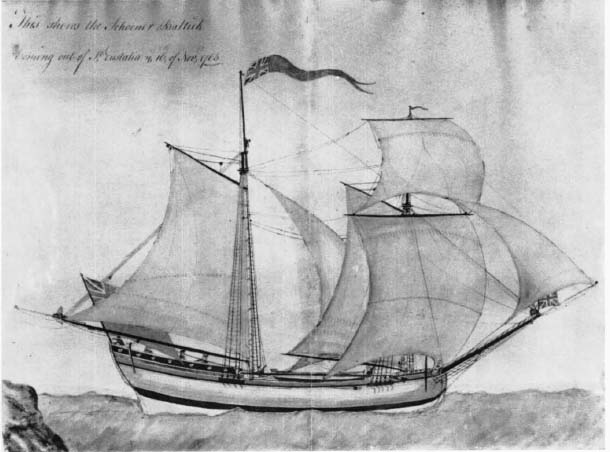
25. Salem schooner Baltick, 1765. (Text p. 26)
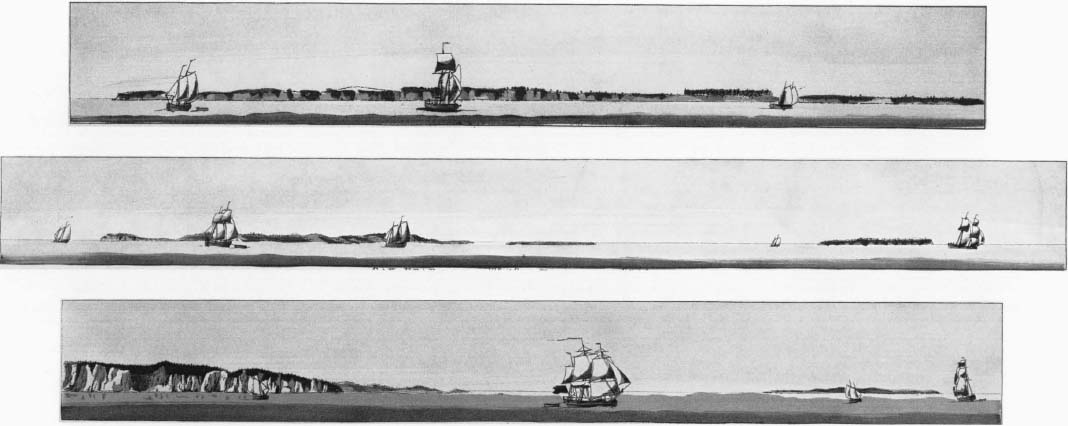
26. Shipping off Cape Poge and Gay Head, from The Atlantic Neptune. (Text p. 27)
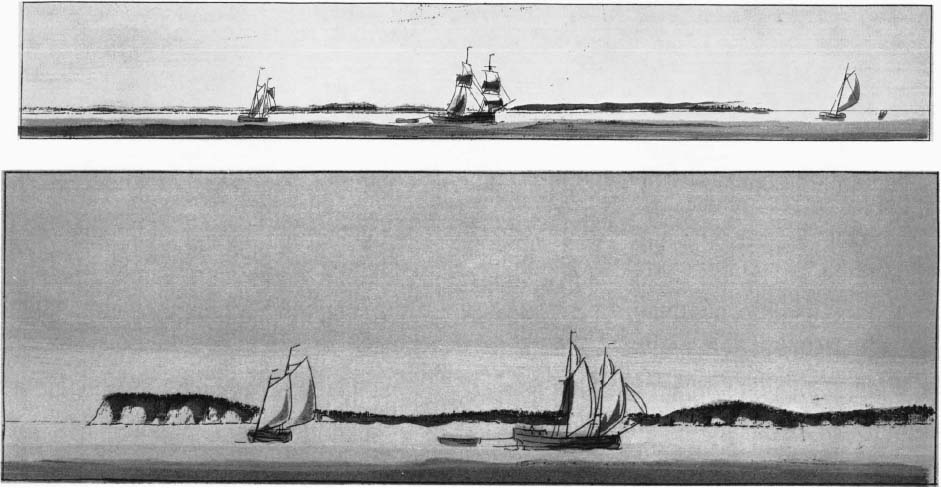
27. Shipping off Sandy Point, Nomansland, and Sankaty Head, from The Atlantic Neptune. (Text p. 27)
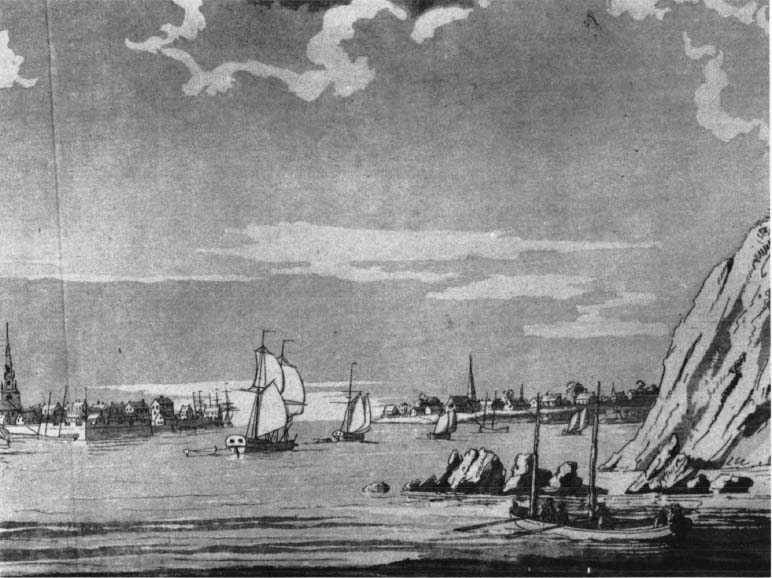
28. Shipping off Boston Harbor, from The Atlantic Neptune. (Text p. 28)
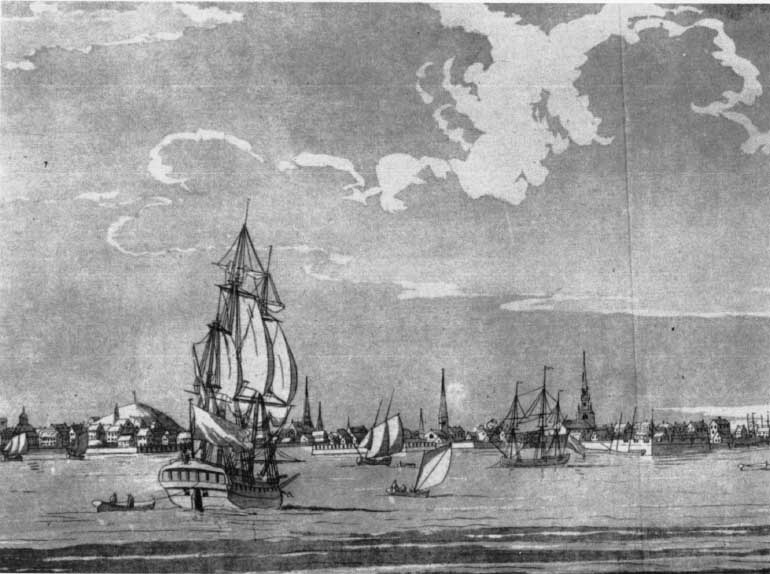
29. Shipping off Boston Harbor, from The Atlantic Neptune. (Text p. 28)
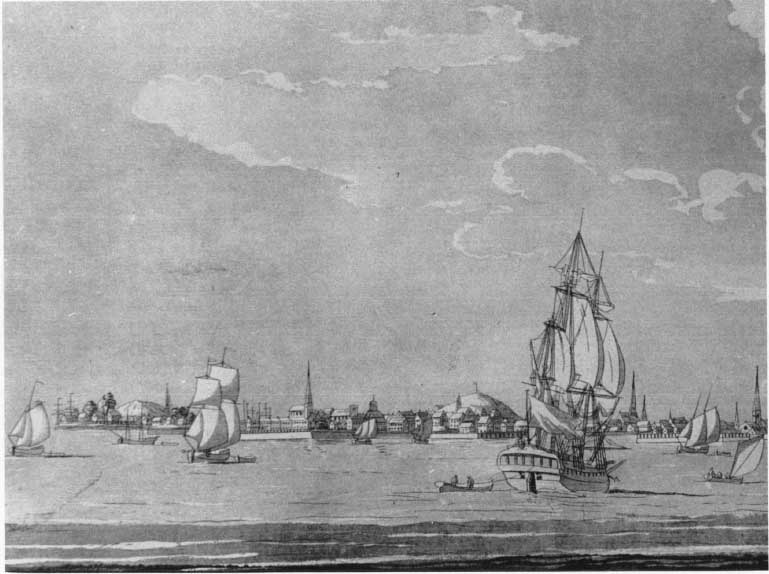
30. Shipping off Boston Harbor, from The Atlantic Neptune. (Text p. 29)
Late Seventeenth Century
Having considered the major types of vessels and boats employed in early seventeenth-century Massachusetts—the ship, bark, pinnace, ketch, and shallop—we can now move on and see how they changed. For the first evidence of change, let us consider Figure 8 taken from what is said to be the first map ever cut in America. This woodcut is thought to be the work of Boston printer John Foster, and it was used to illustrate the Reverend William Hubbard’s A Narrative of the Troubles with the Indians in New England, published by Foster in 1677. The map is unusual to modern eyes, for the viewer is looking west from a meridian drawn just east of Cape Cod.
Shown properly sailing in Massachusetts Bay with a northwest wind are two ships, a bark, a ketch, and a small vessel or large boat that has one mast with a staysail and sprit mainsail. The two ships, both heading a bit west of south with the wind on their starboard quarters, show considerable reduction in their superstructures compared with Mayflower. Both have square topsails over their lateen mizzens, but neither shows a spritsail under the bowsprit although these sails were still standard. The southernmost ship has fore- and main-topgallant sails which by this time were standard on medium-sized ships.
Better details of a late seventeenth-century ship are shown in Figure 9, a portrait of “The William and John—William Stevens [?] Commander” of about 1670 from a watercolor in the British Museum. Her armament is typical—a few guns on the quarterdeck, a fully armed upper deck, but only four guns on each side on the lower deck and these are abaft the mainmast. This left the ’tween deck space forward of the mainmast available for cargo. The single lower deck port amidships was for handling ballast. Note that by this time the first level of superstructure aft had been shortened and its name changed from the half to the quarter deck.
William and John carried topgallants on both fore- and mainmasts, and her spritsail forward is drawing well. At the outer end of her bowsprit is that peculiar seventeenth-century fitting, the sprit-sail-topsail whose rigging must have been the boatswain’s despair. This ship also carries four of the staysails that became common during the 1650s—the main, mizzen, fore-topmast, and main-topmast staysails. They were not set on the actual stays but on auxiliary stays secured beneath them.
Just east of Hull on the Foster map and heading northeast is a large ketch. She is similar to that shown in Figure 7 but she carries two additional sails, a main-topgallant and a mizzen-topsail. A bit further north, about midway between Cape Ann and the Isles of Shoals, and also sailing northeast, is a two-masted square-rigger, very likely a late bark. Although her foresail is larger in relation to her main than on our earlier bark, the proportions between fore and main are maintained by the addition of a main-topsail.
The single-masted craft is in near shore just off Hampton; it is difficult to know what to call her, for by rig alone she cannot be identified. First, she might be a shallop, but in relation to the other vessels she seems too large. Second, she might be a ketch, a possibility that might shock some modern sailors. In the 1680s, however, some ketches measured as small as ten tons. Such a vessel would have been only about thirty feet long on deck, hardly suitable for even a simplified version of the rig shown in Figure 7. Third, she might be a sloop as this type was fairly common in New England waters by 1677. Finally, she might fall into a general category found in many records, that of “great boat.”
During the second half of the seventeenth century, shallops and ketches were respectively the major inshore and offshore fishing vessels employed by Massachusetts fishermen. The shallops are nicely portrayed on a map of New England of about 1680. In Figure 10 a fleet of four rides at anchor with masts down in the waters between Cape Ann and the Isles of Shoals. Three shallops carrying the two-masted square rig, Figure 11, are heading in toward the original Winter Harbor at the mouth of the Saco River. The shallops in these two fleets have the same basic characteristics as the fishing boats shown on seventeenth-century maps of Cornwall. We should not be surprised at this, for men from Cornwall and Devon were the first English fishermen off the Maine coast in the sixteenth century. Fishermen from Cornwall and the Channel Islands settled Marblehead in the seventeenth century.
From court records and other sources, it is apparent that these fishing shallops were substantial craft. They were sheathed inside, were partly decked, and had a cuddy forward that contained a fireplace. A crew of four was standard for fishing—the master, the midshipman, the foreshipman, and a fourth man who remained on shore to cure the fish and cook the meals. The three who manned the shallop fished with handlines from “rooms,” short open compartments extending from side to side of the craft bounded fore and aft by transverse bulkheads. The fish holds between the rooms were decked over and sometimes portable covers were provided for the rooms.
Unfortunately, I have not found any identifiable pictorial representations of late seventeenth-century Massachusetts fishing ketches. Trading ketches probably retained the square rig right through the colonial years, but the type lost its popularity and few were built in the latter part of the period. In 1677 there is evidence for a square rig on a Massachusetts fishing ketch, but in his L’ Architecture Navale published in France in the same year Le Sieur Dassie noted that a “quesche”—his approximation of the English word—had a fore-and-aft rig, and he invented the word “tronc” for the square-rigged version.
As is well known to marine researchers, the Massachusetts Archives contain licenses, passes, and registers of vessels that sailed from Boston between 1686 and 1715. These vessels were engaged primarily on “foreign” voyages, i.e., to any port outside Massachusetts, hence a vessel bound to Portsmouth, New Hampshire, was registered but one heading for Pemaquid was not. Fishing vessels were not registered. These records tell us what types were being used, their tonnage, and the shape of their sterns. There were ships, barks, ketches, and an occasional shallop along with three new types—pinks, sloops, and brigantines.
Ships normally had square sterns: hence, for a simple definition, a pink was a ship with a round stern; there were, however, vessels of other rigs that had pink sterns. Sloops were not so simple. With his six “ratings” and other classifications of vessels of the Royal Navy, Samuel Pepys thoroughly confused the sloop story. After the Restoration of Charles II, the Royal Navy had a number of square-sterned, open boats that had the two-masted square rig; these were considered expendable, were commanded by a petty officer, and were called shallops. Decked vessels so rigged were carried on the official list, were commanded by a junior officer, and were called sloops. Under some conditions such a sloop would set a short-gaff fore-and-aft sail on its tall ensign staff, hence at a quick glance would look like a bark. Further to confuse matters, we cannot overlook Thomas Riley Blanckley’s famous definition in 1732:
Sloop—Are Sail’d & Masted as Mens fancys leads them sometimes with One Mast, with Two, and with Three, with Burmudoes, Shoulder of Mutton, Square Lug & Smack Sails, they are in Figure either Square or Round Stern’d.
During the years covered by the records in the Massachusetts Archives there are about 960 entries for sloops; there is some minor duplication as vessels had to be reregistered when any of their owners changed. In size, these sloops ranged from four to eighty tons with the greatest number measuring between fifteen and forty tons. The majority had square sterns. A few listed as “open” would have been employed in the coastal firewood trade which was important to Boston. For a time Harvard College owned its own firewood vessels which plied between Down East ports and a landing on the Charles. Trading sloops of the late seventeenth century probably had what we recognize as a sloop rig—a short-gaff, fore-and-aft mainsail, a staysail, and a jib; the larger sloops also carried one or more square sails. Figure 12 is a modern reconstruction of a medium-sized sloop circa 1680.
The original name of the third of the new types—brigandine—clearly indicates its derivation, a craft used by brigands or pirates, hence something light and fast propelled by oars and sails. As the late seventeenth- and early eighteenth-century brigantines owned in Massachusetts ranged in size from eight to one hundred tons, all cannot have been built and rigged in the same fashion. It is almost easier to say what brigantines were not than to describe them.
We know that one form of brigantine was alive and well in 1732, therefore Blanckley was thinking of an earlier craft when he wrote: “Not now used, but were built light for Rowing or Sailing & had 2 Masts & square Sails.” A few years earlier, John Harris of London simply put into English Guillet’s French definition of 1686:
Brigantine—is a small light vessel which can both row and sail well, and is either for fighting or giving chase: It hath about 12 or 15 benches for the Rowers, one man to a bench; all hands aboard are soldiers and each one hath his musket lying ready under his oar.
Neither of these definitions bears any resemblance to that in the Oxford Universal Dictionary which states that as early as 1695 a brigantine was recognized as a two-masted vessel with a square-rigged foremast and a fore-and-aft rigged mainmast. To avoid problems that cannot be solved at this time let us accept this statement and note that such a rig is shown in an American painting of about 1715, Figure 13.
The story of the supposed invention of the schooner in Gloucester about 1713 need not be repeated here, for the schooner rig—a two-masted fore-and-aft rig with the second mast as tall as or taller than the first and at least one triangular headsail—existed before that date. It is sufficient to say that “schooner” as a type of vessel began appearing in Boston and Gloucester records in 1716 and by 1720 schooners had practically replaced ketches in the New England fishing fleet. We cannot assume that there was a wholesale scrapping of ketches and the building of replacement schooners or even that major re-rigging occurred. It is more than likely that a newly fashionable type name was adopted for as many somewhat similar vessels as possible along with a few small changes. This then means that by the end of the seventeenth century the smaller fishing ketches had fore-and-aft rigs; there is other evidence to support this argument. As ketches were basically double-ended this also means that the type later called a pinky existed in New England waters for about 200 years.
We can turn now to pictorial evidence for examples of what was sailing in Massachusetts waters in the 1720s. Let us look first at John Bonner’s 1722 map of Boston, which in its first state, Figure 14, showed eleven well-defined vessels with the masts of two more visible behind a wharf. Moored along the south side of Long Wharf are a ship, a sloop, and a brigantine as defined by the Oxford Universal Dictionary. Out in the harbor are three ships under sail, another ship at anchor with her sails furled, a brigantine with only her fore course set, and two sloops.
The eleventh vessel is probably a “two-mast boat” so-called because that description was sufficient and no one could think of a better name. References to two-mast boats appear in various records and newspaper advertisements right through the War for Independence. One variation of the type, an import used for fishing, was the Bermudas boat. She carried two raked masts with loose-footed, jib-headed sails, the ancestors of what we call the marconi rig but which the British have always called Bermudian. Actually it was a Dutch rig that can be traced back to the 1620s in the Netherlands.
The second state of Bonner’s map shows three additional craft on the Charles River. One is a sloop, the second is a schooner, while the third—an open boat being moved by two sweeps—is probably the “Ferry to Charles-Town.”
“A South East View of ye Great Town of Boston in New England in America,” drawn by William Burgis, engraved by I. Harris, and published by William Price, is thought to show the town and its harbor as they appeared in 1722. The print was dedicated to Governor Samuel Shute of Massachusetts and probably was first issued in 1723. We can assume but can never be sure that the boats and vessels shown actually sailed in Massachusetts waters; two of them, a ship and a brigantine, appear again in the George Heap view of Philadelphia published in 1754. For convenience, we shall consider this “View” of Boston in three sections, Figures 15, 16, and 17.
In the foregrounds of these sections are a number of ship-rigged and sloop-rigged vessels of the Royal Navy. Although the full details of some of the former cannot be distinguished they are probably small ships of the line, frigates, and sloops of war. So much has been written by others about such vessels that we need only note here a further reduction in the heights of superstructures from those of William and John. The spritsail topmast at the end of the bowsprit has disappeared but just barely, for 1720 is considered about the last date of its use although some would say 1725 or even 1730.
Starting with the left-hand third of the Burgis view, Figure 15, we find a number of small vessels, some perhaps packets from Braintree, Hingham, and even the landings on the North River. Six are what we would call sloops, single-masted fore-and-aft rigged craft with one or two triangular headsails. None have topmasts or yards and while all the short-gaff mainsails are loose-footed, two of the sloops do not have booms. Two small craft near shore in the left background carry single spritsails and there is one boat with a single square sail.
Outward bound near the right-hand edge of Figure 15 is one of the relatively new schooners; some of her details are confused showing that the artist may not have been fully familiar with the type. This schooner has but three sails, a staysail forward set on a bowsprit and short-gaff fore and mail sails. Both the fore and the main are loose-footed and only the mainsail has a boom.
The center section of the Burgis print, Figure 16, which includes Long Wharf and nearly all of Clark’s Wharf to the north, is cluttered with vessels. Moored along the south side of Long Wharf, starting from the outer end, are a ship; a brigantine; a snow, which was a two-masted square-rigger with a full complement of square sails on both masts; a ship with her topmasts housed; what may be a square-rigged ketch, and three sloops. Without a large-scale print at hand it would be too confusing to continue this enumeration around the waterfront; hence we will limit this discussion to a few specific vessels.
In this center section there is only one well-defined schooner. While all of her hull but the transom are hidden by a warehouse on a small wharf, over the end of Long Wharf, her short-gaff fore- and mainsails tower above the surrounding buildings. She must have been a fairly large vessel.
Against one of our earlier arguments, no vessel in the entire view can be described as a fore-and-aft rigged ketch, but there are several square-rigged ketches in addition to the one noted on the south side of Long Wharf. One is moored to the south side of Clark’s Wharf, and a second is almost hidden against the shore just under the beacon on the hill (whence the now familiar name). A third square-rigged ketch rides at anchor with two sails set just below the outer end of Clark’s Wharf and is just barely seen at the left-hand edge of Figure 17. Two more ketches may be moored to the beginning of the T on the north side of Long Wharf.
There are several of the 1695-type brigantines in Figure 16, the most apparent being the two near the inshore end of Clark’s Wharf and a small one under sail just north of Long Wharf and directly over the brigantine moored to its south side. This little brigantine seems too small for her rig.
Outward bound near the left-hand edge of this section is what may have been among the last of the old square-rigged shallops and there may be another close in to the middle of Long Wharf. The size of the square foresail has increased considerably since the early seventeenth century.
The vessel at anchor just off the port quarter of the first shallop is a bit of a mystery, for she seems to have yards down near her deck. She is quite likely an example of the older brigantine rig that had a deep narrow square sail on each mast with small square topsails.
The general anchoring ground in the Boston harbor of 1722 seems to have been to the north of Long Wharf, for here in Figure 17 we find a large number of vessels riding at anchor. Some of these, however, are rather poorly drawn without proper attention to scale as though intended to fill space. There are a number of ships, some fully rigged, perhaps just arrived from or about to sail on a voyage, while others with topmasts struck are awaiting employment. We might note here the use of the term “galley” in conjunction with a vessel’s name such as Essex Galley or Sarah Galley which was common practice in the late seventeenth and early eighteenth centuries. It did not mean that the vessel was propelled by oars but simply that her hull was shaped more for speed rather than cargo capacity. The practice of combining name and type continued in popular usage, if not always official records, into the nineteenth century when we find expressions such as Brandywine Frigate and the record that has confused steamboat researchers, North River Steamboat, Robert Fulton’s first successful craft.
In the foreground of Figure 17 is a fine example of a pink-sterned brigantine, while above her and slightly to the right is another more sketchily drawn. Near the center of this section another schooner rides at anchor. Her topmasts, which may be for pennants only, are stepped abaft the heads of her lower masts; this practice was common on sloops of that day. Off this schooner’s bow, however, is another mystery, a single-masted vessel that carries a deep, narrow square sail as well as a short-gaff mainsail, a combination having no English name that is occasionally seen in Dutch marine views.
Against the shore just south of the prominent North Battery are two craft carrying single spritsails. They are at the Winnisimet Ferry landing whence travelers crossed the harbor to Chelsea and the highway to Lynn and Salem. In a later state of this print the spritsail-rigged boat off the North Battery is marked “Chelsey Ferry Boat.”
All along the shore, from the northernmost tip of the peninsula to the very left-hand edge of the view among the string of dwellings that mark the single roadway across the neck, are evidences of one of Boston’s major industries, shipbuilding. There are hulls in several stages of construction from an assembly of keel, floor timbers, and sternpost to what may be completed hulls ready for launching.
In 1729, William Burgis drew his well-known view of the Boston lighthouse, Figure 18, and included a fine portrait of a sloop at anchor. H. I. Chapelle thought that she resembled sloops of the Ferrett class built in England for the Royal Navy about 1711. Hazard of this class was wrecked and lost off Cohasset, Massachusetts, on 12 November 1714. Although Burgis’s sloop was a naval vessel she is worth looking at closely, for the larger merchant sloops were quite similar.
The sloop has one deck with relatively high bulwarks that are pierced with seven ports on a side. A quarterbadge shows that she has a “great cabin” aft under a quarterdeck. Her loose-footed mainsail is of the short-gaff type with a long boom. For headsails she has a staysail (or foresail) and a jib; in light weather she may have set a flying jib on the topmast stay. The sloop’s standing yard is shown fitted with foot-ropes, but her lower square sail may have been hoisted to the yard for setting, not furled upon the yard and let fall in the usual way. A light square topsail yard would have been set flying on her topmast which is stepped abaft the head of the lower mast. The gaff topsail was not employed widely until the middle of the eighteenth century.
In Figure 19, we have the first-known painting of a named Massachusetts vessel, the letter-of-marque ship Bethel which was owned by the Quincy family. Probably typical of the better ships of her day, she was armed with fourteen guns and carried a crew of thirty-eight men. In 1748, when Yankee bluff was added to these, she captured a Spanish treasure ship worth close to £100,000 that had twenty-four guns and a crew of 110.
The painting is typical of the period showing Bethel in two positions. With what are the equivalents of the old half and quarter decks, her superstructure aft seems higher than we might expect, but some of this is due to the open rails on the first level. While the spritsail-topmast is gone from the end of the bowsprit, the sail is still there with its yard slung under an extension of the bowsprit, a new spar called the jibboom. Topgallant sails are carried on all three masts. The mizzenmast still has its lateen yard—some examples can be found as late as the War for Independence—but the part of the sail forward of the mast has been cut off.
We come now to the unique colored sketches in the journals of Ashley Bowen, mariner, rigger, &c, of Marblehead. Were he not a professional rigger we might find it difficult to accept some of his details. Small in the originals, these sketches cannot stand much enlargement, and they lose some of their qualities when reproduced in black and white. They are, however, convincing portraits of the vessels that sailed in Massachusetts waters from about 1740 to the end of the colonial period.
Because so many of Ashley Bowen’s sketches are near duplicates, only those of particular interest will be mentioned. Three of the panels of Figure 20 show the sloops that were so prominent in colonial trading, only one of which carries standing square sail yards; Bowen identified the latter as the “bitcy…of St a Crewes” [Betsy of St. Croix]. These panels also show two small schooners rigged to carry four sails only—mainsail, foresail, staysail, and jib.
The two right-hand panels of Figure 21 show better than many words of description the basic features of the two-masted square-riggers of the eighteenth century, the brigantine above and the snow below. Although the 1695-type brigantine was not featured in any of Bowen’s sketches, there is enough scattered evidence to show that it did not disappear completely between Burgis’s 1722 view of Boston and 1775. After the war vessels so rigged were called hermaphrodite brigs.
As the eighteenth century passed, light square sails were added on the main-topmast of the 1695 type of brigantine. The lowest yard never carried a sail, and all yards on the mainmast were shorter than the corresponding ones on the fore. A brigantine could immediately be identified by her long lower mainmast and large fore-and-aft mainsail. It is easy to understand why customs service clerks and others abbreviated brigantine to “briga.” and eventually to brig.
A snow’s lower mainmast was only a little longer than her foremast, all yards on the mainmast were equal to or longer than the corresponding ones on the fore, and she set a course on her main yard. To eliminate any problems between the main course and the mast hoops of her fore-and-aft spanker, the latter was set on a separate light mast stepped a couple of feet abaft the mainmast. Bowen’s snows have standing gaffs for their spankers while the mainsails of his brigantines were lowered for furling. What is now called the true brig rig appeared about 1770. The brig had the mast and yard proportions of the snow and carried a main course but set her spanker directly on the main lower mast in the manner of the brigantine.
In the upper left-hand panel of Figure 21 we have a typical small ship of the mid-eighteenth century. Obviously smaller than Bethel she carries courses, topsails, and topgallants on her fore and main masts but a square topsail only on her mizzen. While she carries a lateen yard, the sail does not extend forward of the mast. Forward we can spot a spritsail yard and a jib furled on the jibboom.
The lower left panel shows two schooners, Swallow and Duke of Cumberland, rigged in a manner not mentioned in textbooks, and the sketches would be dismissed as artistic aberrations were Bowen not a professional rigger. These vessels can be called topsail schooners but, unlike the usual rig which has yards on the foremast, their yards are on the mainmasts only. Once the possibility of such a rig is admitted, examples come to light in many locations, even a Norwegian maritime museum. Dated 1749, this sketch of Swallow may be the earliest representation of a Salem vessel.
Figure 22 shows a snow in the upper left and a schooner with yards on both masts in the upper right. The ship in the lower left, dated 1755 and 1756, has an early example of a standing gaff instead of a lateen yard on her mizzenmast. The 1756 schooner in the lower right has no yards but seems to have gaff topsails on both masts, a rather early example of such sails.
The two ships in the lower panels of Figure 23, Atlantick and Patty respectively which were sailing in 1756, are quite similar to the earlier Bethel. They show how she might have appeared had she been given bulwarks on her half deck. The schooner in the upper left seems to be a small vessel with only a staysail forward. The schooner Rambler of Marblehead, upper right, is worthy of notice for two reasons. One is her standing fore gaff which means that her foresail is furled by brailing to the gaff and mast. The second is, that unlike Bowen’s usual practice as shown on Swallow to the left, the mainsail is furled with the gaff right down on the boom. This may indicate that Rambler’s main was secured by a lacing line or other means to the boom, rather unusual in 1766 as the practice did not become common until the 1840s.
The small craft in the left panel of Figure 24 is much like the Bermudas boat of over a century earlier and quite similar to Dutch boats of the 1620s. Her foresail is loose-footed, but the main has a boom. The build-up aft may just be bulwarks or there may be a small cuddy. The right panel portrays the sloop Eagle with nearly all her sails set. They include the flying jib, jib, course, topsail, topmast studding sail, topgallant sail, mainsail, ringtail, and a “save-all” under the boom. Because it would be blanketed by the course, Eagle’s foresail [staysail] is not set.
Until Ashley Bowen’s sketches were studied fully, the portrait of the schooner Baltick, Figure 25, was considered the earliest painting of a Salem vessel. Built at Newbury in 1763, Baltick is shown coming out of St. Eustatia on 16 November 1765 carrying the normal topsail schooner rig of the period with yards on her foremast only. Because of the location of her foremast, the staysail is very small; both it and her jib are furled, for they would have been blanketed by the course. It was fairly common on schooners of the period to carry dual mainstays and when on one tack for a long period to set up the weather stay to a ringbolt in the waterway abreast the fore rigging. Baltick is carrying a main-staysail on such a stay. The extension on the main boom shows that she could carry a ringtail and she probably had a main gaff topsail as well.
Unlike Bowen’s small sketches, the portrait of Baltick is large enough to show many rigging details. The bobstay is attached to the bowsprit about halfway out to its cap, and the bowsprit shrouds are worked into a netting for protection of the crew and to keep the jib from dropping into the water when being furled. The course has one row of reef points, but its area can quickly be reduced to about one-half by removing the laced-on bonnet. Both fore- and mainsails have provisions for three reefs, the uppermost on the main being a so-called “balance” reef.
The final examples of vessels of our colonial period come from the charts and views that comprise The Atlantic Neptune, published by Joseph F. A. DesBarres for the use of the Royal Navy. The first chart of the series appeared in 1774, and the entire collection came out in 1780. This work is said to be “the most splendid collection of charts, plans, and views ever published.” The several recognition views included are considered among the best contemporary pictures of many of the places shown. These views are enlivened with numerous sketches of various types of vessels, many under sail and all of the types that might have been seen in the locations depicted. Although details are lacking the sketches are convincing.
Figure 26 is a combination of views of Cape Poge and Gay Head, Martha’s Vineyard. To the left in the upper view of Cape Poge is a small schooner on the starboard tack. In the center, broad off the wind, is a larger schooner with a square topsail on her mainmast only and to her port a small schooner close hauled on the starboard tack. The middle view of Gay Head includes a small schooner heading away on the port tack with a double topsail schooner and an ordinary schooner heading toward us on the starboard tack. The bottom view shows a small sloop in near Gay Head and a ship heading offshore under easy sail—jib, fore course, and three topsails.
A second combination, Figure 27, depicts vessels off Nantucket and Martha’s Vineyard. In the upper view showing Sandy Point [now Great Point], Nantucket, we find a small schooner, a brigantine, and a sloop, all sailing from left to right. The middle view, off Nomansland, shows a schooner in the distance and another brigantine. Off Sankaty Head in the bottom view, we see to the right a small schooner running before the wind with her fore- and mainsails set wing-and-wing; she seems to have gaff topsails on both masts. Astern of her, heading toward us on the starboard tack, is a large two-mast boat. By this time, such craft were commonly called Chebacco boats, after the building place of large numbers, the Chebacco parish of Ipswich which is now the town of Essex, Massachusetts. Continuing to the left, to part of the previous lower view of Gay Head, we find, as seen from off her port quarter, a brigantine running and a small schooner coming toward us on the port tack.
Our final vessels are from A View of Boston which we will consider in three sections. Figure 28, the right third, shows an open two-mast boat proceeding under oars close in to the shore of Governor’s Island which, as we know, has been cut down and included in Logan Airport. She carries furled spritsails on her two masts. In the 1770s such a craft could have served for short coastwise passages, for fishing, as a pilot boat, and even for doing some of the sounding and surveying for the charts in The Atlantic Neptune. Just above this craft and in near Noddle’s Island, now East Boston, are two larger two-mast or Chebacco boats standing out under sail on the starboard tack; they are probably fishermen. Heading up the main channel between Noddle’s Island and the north end of Boston are a brigantine and yet another schooner with a square topsail on her mainmast only.
The center portion of the Boston view, Figure 29, shows in the background a ship riding at anchor with all sails furled; she carries a lateen yard on her mizzenmast. Off her bow a schooner is heading down the harbor on the starboard tack. Just below her is a small open boat running up the harbor under a single spritsail. The large ship is under three topsails only, the fore course and the two topgallants having been clewed up and left hanging in their gear. Some of the crew are on the main-topgallant yard about to furl the sail. Unlike the ship at anchor, this one has a standing gaff on her mizzenmast.
In the left-hand section, Figure 30, we find the ship repeated and, to her port, two sloops, an ordinary schooner, and a double topsail schooner are outward bound on the starboard tack. In the background, just above the ship’s port quarter is Beacon Hill on the far side of which this paper was read at a Colonial Society symposium on 21 November 1975.
